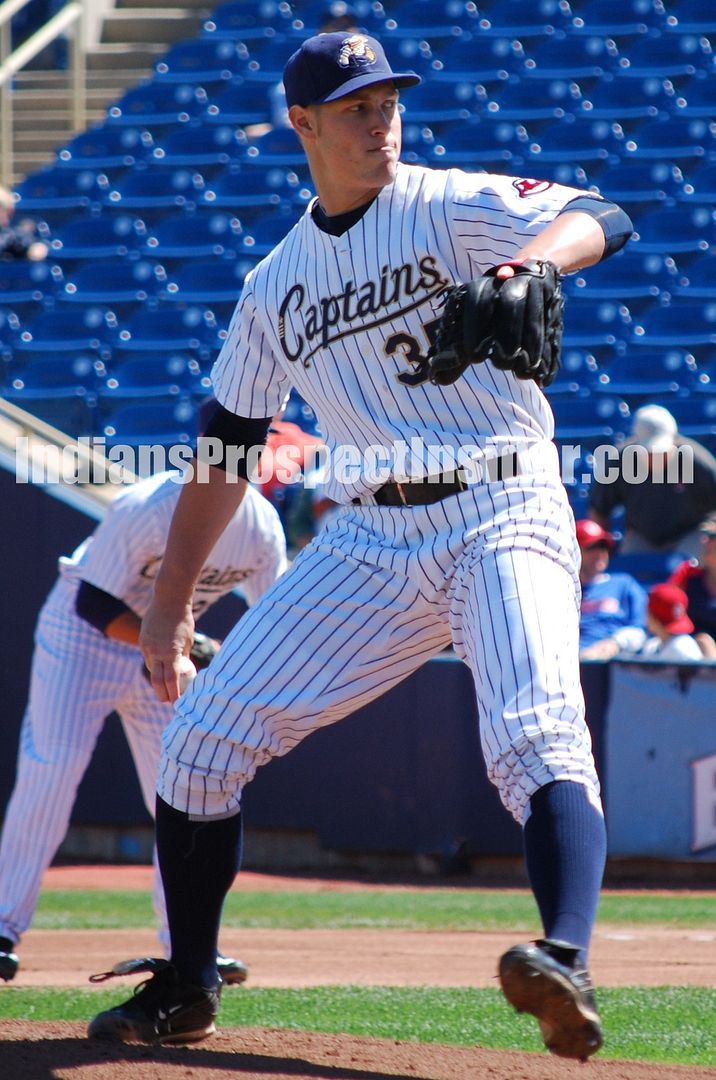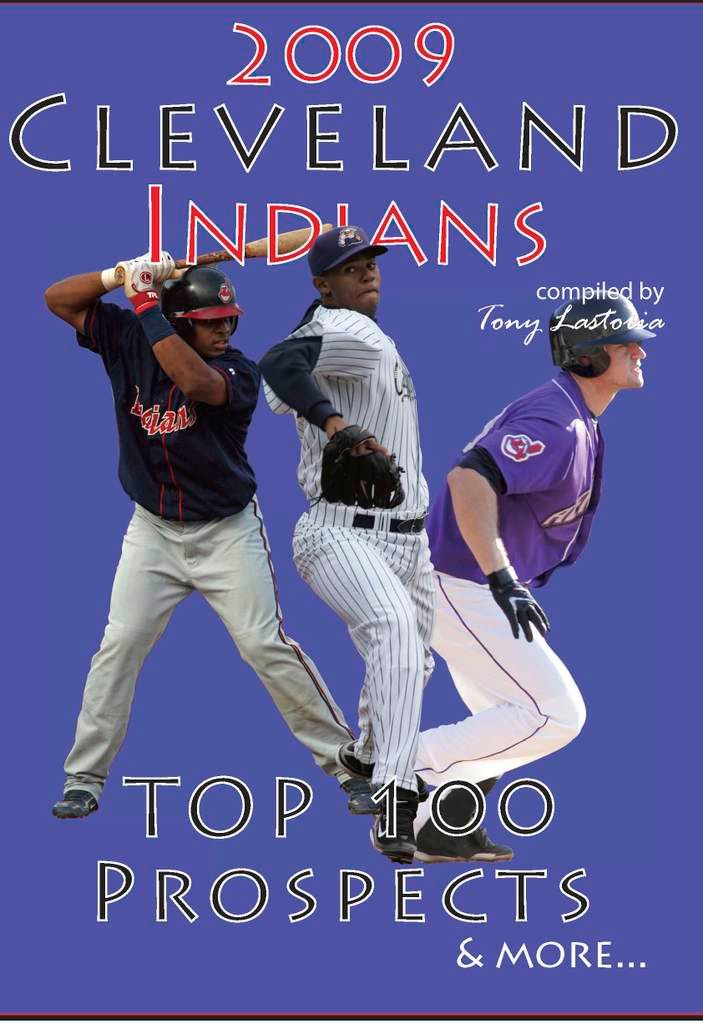Jason Knapp – Right-handed Pitcher
Born: 08/31/1990 – Height: 6’5” – Weight: 235 – Bats: Right – Throws: Right
 |
| (Photo: Tony Lastoria) |
Strengths: Knapp is a physical, raw pitcher with a big, powerful frame. He has an arm that unleashes a blazing plus-plus fastball that lights up a radar gun consistently at 93-96 MPH and has touched 99 MPH. Because of his youth and tremendous arm strength a lot of people feel as he matures and cleans up his mechanics that he could potentially get his fastball up over 100 MPH. He flashes an above average 12-6 power curveball that he gets good rotation on and has plus potential. He shows a lot of confidence in his curveball and an ability to throw it for strikes and it has developed into a second swing-and-miss pitch for him. His changeup is still raw and a below average pitch, but he continues to make good strides with it and it has potential to be an average to above average offering for him. He also has a slider in his arsenal, but it has been shelved until the command and control of his fastball and other secondary pitches improve.
With his size and build Knapp looks like a linebacker and is an intimidating presence on the mound for opposing hitters. He has a powerful, very aggressive, big delivery and throws the ball from a low-three quarter arm slot. He is a competitor who thrives on the competition and the excitement of being out on the mound. He is very mature and professional for his age, and is extremely driven, disciplined, and very hardworking. He is from a cold weather state (New Jersey), so should have no problem adapting and pitching in the cold in the Cleveland area.
When the Indians acquired Knapp in July of 2009 he had been on the disabled list with bicep tendonitis, but because MLB does not allow an MRI to be performed to complete a trade they were unaware that there was a more serious issue with his shoulder that eventually resulted in offseason arthroscopic shoulder surgery and forced him to miss most of last season as he rehabbed from the surgery. His return to pitching was slow last year, not because he was having setbacks, but because the Indians were overly conservative so as to ensure as best as they could that there would be no hiccups with his recovery. Were he an older pitcher and one closer to the big leagues he may have been back pitching as soon as April or May last year; however, because of his youth, arm, projection and outstanding talent, the Indians erred on the side of extreme caution and he did not start pitching in games until late July.
The most encouraging thing about Knapp last year was the discipline he showed getting back to pitching form and getting himself back in a position to compete on the baseball field. What he did in his therapy and how he approached it is something normally expected from a 35-year old big leaguer. His long absence from pitching helped him become even stronger and in the best shape he has ever been in, which is a credit to his outstanding work ethic. He also became more of a student of the game in understanding what it takes to “pitch” rather then just “throw” like so many young pitchers do. He worked his but off to get back to 100% and by the end of the season was topping out at 99 MPH again.
Opportunities: Knapp has front of the rotation stuff and ability, now it is all about building his execution and command of all his pitches. Everything is raw with him, be it his delivery, command, or his pitches, which makes him such a high risk high reward kind of pitcher because of the untapped talent and such huge upside which could go in either direction as he matures. He has always been a thrower more than a pitcher and lacks a feel for pitching, but he showed some improvement in that area last year thanks to all the down time he had. Now that he is healthy again he can start to apply some of the things he learned last season with understanding how to pitch, so it will be interesting to see how it translates going forward.
Any time a pitcher has surgery on their shoulder, no matter how minor, it is a big red flag. Knapp will need to prove that he is 100% recovered from the surgery and that he can be a durable, reliable pitcher going forward. His mechanics are still very raw and inconsistent, which leads to some command issues, but for a pitcher like him command can often be the last thing that comes. His delivery is kind of awkward as he doesn't close his front shoulder when he plants on his front leg, which many people think could lead to more health concerns down the road. Refining his delivery is a must and is something the Indians will obviously focus with him on improving now that he is healthy. His secondary offerings need a lot of work as while they flash plus ability, they are very inconsistent. To remain a starter he will need to be more consistent with his curveball, and his changeup still needs a lot of work.
Outlook: Even with the lost year recovering from offseason shoulder surgery, Knapp is still way ahead in his development than most young pitching prospects. He pitched in Instructional League in the offseason to help makeup for some lost time last year, and then remained in Goodyear most of the offseason to take some college courses at a local college and at the same time continue to strengthen up his shoulder, improve his overall strength, and be in great shape for this coming season. He is still very young and rough around the edges so will require a lot of patience with his development the next few seasons, but with his youth, size, stuff, and projection there is a ton to like about him. The key going forward – like with any pitcher – will be health. What he turns into no one knows at this time, but he has the goods where he could end up as an elite power front of the rotation starter who eats innings, or he could end up as a guy who just has two excellent pitches and is a ninth inning closer. He should open the 2011 season in the starting rotation at High-A Kinston.
| Year | Age | Team | Lvl | W | L | ERA | G | GS | IP | H | ER | HR | BB | SO | AVG | BB/9 | K/9 | WHIP |
| 2008 | 17 | GCL Phillies | R | 3 | 1 | 2.61 | 7 | 6 | 31.0 | 26 | 9 | 1 | 12 | 38 | .228 | 3.5 | 11.0 | 1.23 |
| 2009 | 18 | Lakewood | A | 2 | 7 | 4.01 | 17 | 17 | 85.1 | 63 | 38 | 3 | 39 | 111 | .208 | 4.1 | 11.7 | 1.20 |
| 2009 | 18 | Lake County | A | 0 | 0 | 5.40 | 4 | 4 | 11.2 | 10 | 7 | 0 | 8 | 12 | .238 | 6.2 | 9.3 | 1.54 |
| 2010 | 19 | AZL Indians | R | 0 | 2 | 1.46 | 5 | 5 | 12.1 | 5 | 2 | 0 | 4 | 18 | .119 | 2.9 | 13.1 | 0.73 |
| 2010 | 19 | Lake County | A | 1 | 0 | 3.94 | 4 | 4 | 16.0 | 12 | 7 | 0 | 8 | 29 | .207 | 4.5 | 16.3 | 1.25 |
| MiLB Totals | 6 | 10 | 3.63 | 37 | 36 | 156.1 | 116 | 63 | 4 | 71 | 208 | .208 | 4.1 | 12.0 | 1.20 |
Follow Tony and the Indians Prospect Insider on Twitter @TonyIPI. Also, his latest book the 2011 Cleveland Indians Top 100 Prospects & More is available for purchase for $20.95 to customers in the US (shipping and handling extra).














 Everything on this site is free, but for those interested in making any monetary contributions to help support the stability and growth of this site please click on the "Donate" button below.
Everything on this site is free, but for those interested in making any monetary contributions to help support the stability and growth of this site please click on the "Donate" button below.


3 comments:
haven't been this excited over a pitcher since bartolo in the 90s. fingers crossed he doesn't flame out.
Watching that video literally made my elbow hurt. If I am not mistaken, he has an Inverted L, or at least that's what is looks like from the third base view. It looks similar to Scott Williamson's Inverted L. Oh well, as long as it is not the Inverted W, all I would be is cautious instead of worried when it comes to handling him. Nonetheless, he is a very intriguing pitcher and if he develops like we all hope and also in a timely manner, he will be able to help the Indians greatly in 2015 and 2016 - the next plausible window that I think the Indians could contend for a World Series.
Oh come on. Scott Williamson was completely different. He was very high effort in the upper half of his body. Williamson was 5'10", 175 lbs and threw upper 90s pretty much all with his upper body. Knapp is nothing like Williamson.
Also, I've heard well informed scouts complain about guys' deliveries and they never had an injury (Tim Lincecum, for one, was supposed to lose an arm his delivery was so violent at Washington). On the other hand, Mark Prior had the perfect delivery and was supposed to be able to throw 220 innings a year with no problem. Point is that pitching injuries are very difficult to predict.
Post a Comment